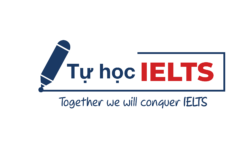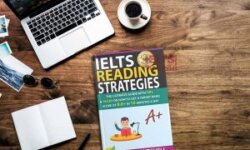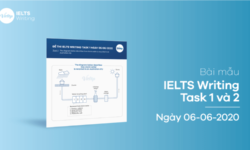Các bạn có thể đọc hoặc tải File PDF về ở cuối bài nhé. Nếu đỡ tốn dung lượng bạn có thể lưu link Web này lại có thể xem nhé. https://www.tuhocielts.vn/ielts-reading-and-some-techniques-to-improve-ielts-reading-skills-for-students/
Xem thêm:
- Tổng hợp 100 Topics cho IELTS Speaking
- Improving IELTS Listening skills for ATC students of Banking Academy
- CHÌA KHÓA TRẢ LỜI MỌI CÂU HỎI IELTS SPEAKING
- Ebook Writing IELTS Miễn Phí
1. Introduction
The burgeoning number of students entering overseas universities and the international labor market has prompted a necessity to establish a standardized language test for the evaluation of leaners’ language proficiency. As a result, one of the most extensively employed tests serving this purpose is the International English Language Testing System (IELTS). IELTS has become a worldwide trusted mechanism to assess learners’ ability, thus having been integrated in the curriculum of many education systems.
The test covers four skills including Reading, Listening, Writing, and Speaking. Each skill demands distinctive teaching methods to stimulate the motivation in students. There has been numerous research into the strategies for imparting the modules regarding Listening, Writing, and Speaking whereas the field of Reading has not received much attention.
Reading has never been considered as an interesting task, especially when it comes to reading tasks of more than 2000 words with intensive acquisition. Furthermore, the constant exposure to academic language together with extensive background knowledge has debilitated any attempt to conquer the lengthy and nerve – wracking IELTS reading passages.
Hence, they have posed a real challenge to instructors in the long-term for the maximum effectiveness of transferring the skills to learners of different levels. This study works on the effort to identify the applicable reading teaching techniques to IELTS Reading exam for leaners on the preparation of the test.
2. General perceptions of reading
2.1. What is reading?
Reading can be regarded as an activity of intensive interaction between readers and the passage which leads to reading fluency. Reading requires a great deal of efforts from readers to decipher the true meaning by using a variety of linguistic and expertise knowledge. Moreover, the complexity of reading has triggered many researchers’ endeavor to perceive and work out the smooth reading process by scrutinizing the process of element skills (Grabe, 1991). Consequently, researchers have pinpointed the componential skills as followed:
- 1. Automatic recognition skills
- 2. Vocabulary and structural knowledge
- 3. Formal discourse structure knowledge
- 4. Content/world background knowledge
- 5. Synthesis and evaluation skills/strategies
- 6. Metacognitive knowledge and skills monitoring
Studies carried out over the last thirty years has changed our assumption of reading as a process of decoding. As Carrell and Eisterhold considered reading as a “guessing game’ in which the ‘readers reconstruct, as best as he can, a message which has been encoded by a writer (1983, p. 554) As Grabe view reading as an “active process of comprehending [where] students need to be taught strategies to read more efficiently (e. g., guess from context, define expectations, make inferences about the text, skim ahead to fill in the context and so on)”. (1991, p. 377)
Paran believed that reading is an “activity involving constant guesses that are later rejected or confirmed’. That is, a reader does not read all the sentences in the same way but relies on a number of words – or ‘cues’ – to guess the coming sentences” (1996, p.25). Zhang (1993) believes that Afflarbach compares reading process to hypothesis testing (or draft-and-revision) where the reader arrives at the main idea after revising the initial hypothesis, provided that the reader holds relevant background knowledge.
2.2. Classification of reading
- Classification of reading according to the reading manner
The word reading has a number of common interpretations. It may mean reading aloud, a very complex skill, which involves understanding the black marks first and then the production of the right noise or reading may mean silent reading and this is the interpretation (Moorman et al, 1994).
- Classification of reading according to the reading purposes
To the extent of purposes, reading can be classified into extensive reading and intensive reading.
2.2.1. Intensive reading
As reading intensively, readers have in their mind the purpose of achieving full understanding of the logical argument, the rhetorical arrangement or patterns of the text, its symbolic, emotional and social ever stones, of the attitudes and purposes of the author and of the linguistic means that they employ to achieve their ends. This type of reading means ‘reading short texts to extract specific information, this is an accuracy activity involving reading for details’ (Grellet, F., 1990:2)
The objective of intensive reading is understanding a text in detail.
2.2.2. Extensive reading
This is the case in the context that readers have general understanding of the text without necessarily understanding every word (Hedge, 2003). The object of this kind of reading is to cover the greatest possible amount of text in the shortest possible time. Skimming and scanning are of this type.
For skimming, readers go through a passage quickly, jumping over parts of it in order to get the general idea of what is about. People read skimmingly to get the gist of the text but not to find the answer to particular questions. According to Wood, J. (1990: 92) in “Teaching English as an International Language’ skimming occurs in the followings:
When the reader looks at the content page of the book, or at the chapter headings, sub headlines, etc. This is sometimes called previewing. Another example is when the reader glances quickly through a newspaper to see what the main items of the day. This will often mean just glancing at the headlines.
If the purpose of the reader is to find out which chapter of a book is about geography or which advertisements in the newspaper show information about housing, people need scanning for relevant details. It is the case when readers go through a text vary quickly in order to find a particular point of information. In fact, this kind f reading is selected as people are looking at indices, dictionaries, maps, labels, reference materials, advertisement, etc (Hafiz, 1989).
To this kind of reading, readers are required a very deep understanding of the blackmarks on the paper with short texts. They must achieve full understanding of the logical argument, the rhetorical arrangement or patterns of the text, its symbolic, emotional and social over stones, of the attitudes and purposes of the author and of the linguistic means that they employ to achieve their ends (Haller, 2000).
Through intensive reading, readers must arrive at a profound and a really detailed understanding, not only of what it means but also of how the meaning is produced. The question ‘how’ here is as important as the question ‘what’.
3. Reading in IELTS
3.1. Purpose of the reading test
The IELTS Reading test is designed to assess reading command of candidates with a variety of skills. In particular, it is to check how well the readers read to get the general sense of a passage, how well they get the main ideas, the detail, how well they understand inferences and underlined meaning, how well they recognize a writer’s opinions, attitudes and purpose, how well they can follow the development of an argument.
Xem thêm
- Tải sách Cambridge Grammar for IELTS PDF miễn phí
- BÍ KÍP TỰ HỌC IELTS TỪ CON SỐ 0 LÊN 8.0
- Cambridge IELTS 3
- Từ vựng theo 22 chủ đề khác nhau trong IELTS Speaking
3.2. IELTS reading overview
There are three passages in the IELTS reading test totaling approximately 2,500 words taken from books, journals, magazines and newspapers. These passages are written for a non-specialist audience and are on academic topics of general interest and involving a wide range of academic subjects: astronomy, cultivation, history, etc… (Gabb, 2000). They range from the descriptive and factual to the discursive and analytical. Each text might be accompanied by diagrams, graphs or illustrations, and candidates are expected to show that they understand these too.
There are 10 to 15 questions following each reading passage. The questions are of a variety types: multiple choice, matching, true/ false/ not given, sentence completion or summary tasks.
A reading test comprises of three sections:
- Section 1 contains two or three short factual texts, one of which may be made up of 6 – 8 short texts related by topic, e.g. hotel advertisements. The topics are relevant to everyday life in an Englishspeaking country.
- Section 2 contains two short factual texts focusing on work-related issues, e.g. applying for a job, company policies, pay and conditions, workplace facilities, staff development and training. Section 3 contains one longer, more complex text on a topic of general interest.
3.3. Reading competence requirements
Each IELTS reading lasts 60 minutes. Candidate are supposed to be able to skim – to read around 170 words a minute and do not spend as long as 15 minutes in total reading three passages.
To be able to deal with the requirements in IELTS reading, students must have ability to:
- Skim-read quickly. Candidates are supposed to identify the main idea of each reading passage in general and of each paragraph in particular. To fulfil this, it is advised that students do not read supporting sentences and ignore unknown words or phrases (Drucker, 2003).
- Identify key words. With this, students scan the reading texts and the questions to spot the names of people, names of places, and dates that are in the reading passage.
- Identify paraphrase. Students should be able to identify the similarity in the meaning of the questions and that expressed in the reading passage (Grelette, 1990).
- Manage time. The reading test are made up of 40 questions of which, some are easy, others are of medium difficulty and the rest are extremely difficult. In order to score the best, student should concentrate on the easiest questions that they can answer before spend the remaining time for more difficult ones.
- Expand vocabulary. For IELTS readings are for academic purposes. There is a requirement for a good command of words, expressions and phrases (Brown, 1994). Students are advised to enrich their academic vocabulary as much as possible.
4. Some implications to enable students to acquire IELTS high score
Most researches on reading now focus on the effective reading strategies that increase students’ comprehension.
It is essential for teachers of reading classes to recognize the learning objectives for their students who are supposed to have capacity to read a variety of reading texts in English about various subjects. At the same time, reading class is to build a linguistic knowledge to facilitate reading command as well as schematic knowledge (Abraham, 2002). Furthermore, teachers are advised to equip their students with ability to adopt adequate reading style for different purpose and develop their awareness of the structure of any reading passages
- Teachers should teach anything important before their students see the reading passages
This is the pre- reading stage in any reading class. This stage set orientation, motivation and choice of reading strategies for students to cope with upcoming reading passage. In this stage, teachers are assumed to provide their students with vocabularies, active background knowledge and some reading skills (Hammer, 1992).
- Teachers should use analogies conduct skimming and scanning
Normally, this is advised in the while – reading stage which aims at developing students’ competence in comprehending a written passage with both linguistic and schematic knowledge (Abott et al, 1990). Students may have some obstacles in recognize the difference between these two reading strategies and teachers are suggested not to teacher them together
- Before skimming, teachers should use flashreading and predicting
Prior to skimming, Flash-reading is advised to use . This involves trying to get as much information as possible from a text in a very short time (Anthony & Richards, 1980). The major goals of flash-reading are to predict the topic by looking at titles, subtitles and headings, and to work out the thesis statement. Then, when the students read the passage again, they would identify the topic after 3 -5 minutes skimming the passage and confirm their pre- assumption.
- Checking questions should be asked after skimming
This is the job of the teacher to give their students questions for those the answers can be produced simply and that generate the specialist background knowledge in the reading passages. These questions are to force students to read the whole reading passage again (Carrell et al, 1989).
- Teachers should ask their students to do summarizing in pairs
Students are asked to spend about 2 – 3 minutes summarizing the text with a partner without looking at the reading passage. This activity is considered as a good way to see if students have picked up the main ideas in the reading text.
- Paraphrasing techniques should be demonstrated from the questions
Reading classes are to give students opportunities to practise some skills whereas, in test situations, students are supposed to be countable on their existing competence and familiar strategies. Teachers, therefore, are advised to introduce new techniques and get their students masters them through exercises and questions. Teachers then should demonstrate some paraphrasing techniques with the first question as an example, and then get students to practice the remaining questions by them selves or with a partner.
- Students should practise guessing unknown words
Unfamiliar words is always an obstacle for every reader. Students, therefore, should practice guessing unknown words when learning reading. Teachers are advised not to give definitions of the words straight away but try to demonstrate the contextual clues. In IELTS reading, unfamiliar word are often technical terms and students can find a clear definition of the word in the passages. In other context, logical connectives, parallel expressions and collocating words can also provide enough clues to work out the meaning of an unknown word.
- Teachers should set their students realistic goals
It is certainly quite infeasible to set a goal that students get 40 correct answers. To achieve 27 correct answer should require adequate time management skills. Notice should be given that 30 out of 40, equivalent to IELTS 7.0 in the Academic score is a very good one and students should concentrate on the 27 easiest question rather than the 13 most difficult ones.
- There should be a separation between academic vocabulary and technical vocabulary
It is certain that, when reading, students come across many unknown words because reading texts in IELTS are rather academic. And it is the teacher’s role to enable students to identify the right words to learn. There are 3 groups of vocabulary:
- Mainstream vocabulary. There is an estimation of 2000 – 3000 words in English and these are considered as everyday language and most of them are known to the students
- Formal vocabulary. This group consists of around 1000 word families in which, many adjectives and verbs are included. These words are not commonly used in daily communication but many of them are again known to students.
- Specialized vocabulary. This accounts for the largest proportion in IELTS Reading. They, however, are always defined in the reading passage. Students should be helped to identify the difference between the two last groups of vocabulary and put priority to acquire academic vocabulary.
Students should be encouraged to do taskbased reading outside class Students are advised to practice what they have learnt in reading class because reading requires a corporation of reading skills, linguistic competence and adequate reading strategies. This can only be obtained through a lot of practice.
Below are examples of task – based reading:
- identify the topic sentence
- identify academic words and technical words in the reading passage
- identify pronouns with the nouns
- find the writer’s argument and do some writing to respond
- find names of people with their opinion or idea and paraphrase it
Xem thêm:
- Tổng hợp đề IELTS Writing
- Trọn bộ 5 Complete Skill for IELTS by Collins- Ôn luyện IELTS cực hiệu quả
- Luyện IELTS hiệu quả với trọn bộ Get Ready for IELTS by Collins
5. Conclusion
The number of people wishing to study overseas or to take a course offered in English is increasing and the International English Language Testing System (IELTS) is popular as these people have to sit for this test to assess if their English is good enough to enroll such courses. In this paper, the authors look into reading skill to the extent of IELTS reading description, reading skill requirements and then give some suggestions for teachers to perform well in reading class in order to enable their students to get the highest possible score in the test.
6. Đọc IELTS và một số kỹ thuật nâng cao kỹ năng đọc IELTS cho Sinh viên
Tóm tắt: Hệ thống kiểm tra tiếng Anh quốc tế (IELTS) được công nhận là một công cụ để đánh giá liệu một người có thể học hoặc đào tạo bằng tiếng Anh hay không. Mỗi năm, hàng ngàn sinh viên tham gia kỳ thi IELTS. Tuy nhiên, số lượng những người được công nhận đủ khả năng tham gia một khóa học bằng tiếng Anh còn nhiều hạn chế, đặc biệt là đối với những sinh viên không theo học chuyên ngành tiếng Anh tại các trường đại học.
Kỹ năng Đọc IELTS được coi là một kỹ năng khó và có tầm quan trọng tương đương với các kỹ năng nghe, nói và viết trong việc đạt được các mục tiêu của IELTS tại mức 6 hoặc 6.5. Là giáo viên dạy tiếng Anh tại một cơ sở đào tạo, các tác giả nhận ra rằng sinh viên có thể cải thiện kỹ năng đọc của mình dưới sự hướng dẫn chi tiết của giáo viên.
Từ khoá: Kỹ năng đọc IELTS; Kỹ năng đọc lướt; Kỹ năng đọc quét; Nội dung học thuật.
Các bạn DOWNLOAD tài liệu trên về: TẠI ĐÂY








Bình luận